Exploring the Environmental Impact of Membrane Bioreactor in Wastewater Treatment
Exploring the Environmental Impact of Membrane Bioreactor in Wastewater Treatment
Blog Article
Understanding Membrane Bioreactors: The Future of Wastewater Therapy
Membrane bioreactors (MBRs) stand for a notable technology in the area of wastewater therapy, integrating biological procedures with sophisticated membrane layer purification to improve effluent top quality. As worldwide water deficiency and rigid governing frameworks end up being significantly pushing problems, MBR modern technology supplies an efficient feedback via its ability to minimize impact and maximize source recuperation. Nevertheless, the fostering of MBRs is not without its obstacles, which warrant cautious factor to consider. What are the key elements influencing their execution and lasting stability in numerous contexts? The answers may improve our approach to wastewater management.
What Are Membrane Bioreactors?

The core elements of MBR systems consist of a bioreactor where microbial activity takes place and a membrane layer unit that filterings system the combined alcohol. This dual performance makes it possible for the simultaneous destruction of raw material and solid-liquid splitting up in a solitary action. MBRs can run in both submerged and external arrangements, with immersed systems being extra usual because of their compact design and functional performance.
The fostering of MBR technology has actually obtained traction in numerous applications, ranging from local wastewater therapy to commercial effluent monitoring. MBRs are especially advantageous in situations where space is rigid or restricted effluent high quality criteria need to be satisfied. By maintaining a high focus of microbes within the bioreactor, MBRs boost the degradation of natural contaminants, thus producing greater therapy efficiencies contrasted to conventional methods.
Key Advantages of MBR Modern Technology
The integration of organic treatment with membrane layer filtration in MBR systems supplies various advantages that set it besides typical wastewater therapy methods. One of the key advantages is the boosted effluent top quality. MBRs efficiently eliminate suspended solids and virus, accomplishing higher degrees of filtration that fulfill strict discharge requirements and promote water reuse applications.

One more considerable benefit is the lowered sludge manufacturing. MBR systems create less excess sludge, bring about reduced disposal expenses and a decrease in ecological impact. The closed nature of the membrane system lessens the risk of smell discharges and boosts overall procedure control.
Lastly, MBRs are flexible and adaptable, making them appropriate for different wastewater types, consisting of industrial and community sources. The ability to integrate with advanced therapy technologies additionally enhances their effectiveness, making MBRs an appealing service for the future of wastewater monitoring.
Challenges and Limitations of MBRs
While MBR technology offers numerous advantages, it additionally encounters a number of obstacles and constraints that learn this here now can affect its extensive adoption. One substantial challenge is the high resources and functional prices related to MBR systems. The initial investment for membrane layer materials and the necessary framework can be substantial, making it less obtainable for smaller markets or towns.
Additionally, membrane fouling remains a vital try this site issue that can decrease system performance and boost upkeep needs. Fouling occurs when solids, organic issue, or microbes build up on the membrane layer surface area, causing minimized leaks in the structure and calling for regular cleansing or substitute.
One more restriction entails the intricacy of the technology. MBR systems require proficient workers for procedure and maintenance, which can be an obstacle in regions with limited technical proficiency. The disposal of spent membranes presents environmental issues, as the products are frequently not naturally degradable and can add to squander administration challenges.
Last But Not Least, while MBRs can properly deal with a variety of wastewater, they might not be suitable for all applications, especially those with high focus of fats, oils, and oils, necessitating further study and development to address these constraints.
Applications of Membrane Bioreactors
In different sectors, membrane layer bioreactors (MBRs) have actually become a versatile option for wastewater therapy (Membrane Bioreactor). Their applications cover local, industrial, and agricultural settings, showcasing their adaptability and effectiveness in varied environments. In community wastewater treatment plants, MBRs considerably enhance effluent high quality, permitting water reuse and reducing the ecological effect of discharged wastewater
Industrially, MBRs are used in food and beverage processing, fabric production, and pharmaceutical production, where they successfully content treat high-strength waste streams. Their capability to deal with varying and varying loads impurity concentrations makes them specifically beneficial in these industries. Additionally, MBRs facilitate the elimination of pathogens, suspended solids, and organic issue, contributing to compliance with rigid discharge regulations.
In farming, MBRs are significantly made use of for dealing with agricultural runoff and animals wastewater, enabling the recuperation of nutrients for fertilizer manufacturing. They additionally aid in the treatment of greywater for watering, promoting lasting water management practices.
The convenience of MBRs is additional shown by their assimilation with various other technologies, such as anaerobic food digestion and progressed oxidation procedures, enhancing total efficiency and resource recovery in wastewater treatment systems.
The Future of Wastewater Therapy
Improvements in modern technology and an expanding emphasis on sustainability are forming the future of wastewater therapy. Membrane bioreactors (MBRs) exemplify this shift by integrating biological treatment processes with membrane layer filtering, causing top quality effluent suitable for reuse. The pattern in the direction of circular economic climates is triggering centers to take on MBRs for their ability to recover sources, such as water and nutrients, from wastewater.
Technologies in membrane layer products and arrangement are boosting the performance and durability of MBR systems, decreasing functional costs and power intake. Smart technology assimilation, including real-time monitoring and automated control systems, is additional enhancing performance and enabling predictive upkeep, hence minimizing downtime.
Additionally, governing stress and societal assumptions are pushing communities and markets to embrace even more lasting practices. Membrane Bioreactor. The shift towards decentralized wastewater therapy services is getting grip, allowing for local treatment that lowers transport prices and energy usage
Final Thought
Membrane bioreactors (MBRs) stand for a transformative approach to wastewater therapy, incorporating organic procedures with advanced membrane layer innovation. The benefits of MBRs, including improved effluent quality, reduced spatial demands, and reduced sludge production, place them as a feasible option amidst expanding urbanization and more stringent environmental laws. In spite of existing challenges, the continued innovation in membrane layer products and operational techniques promises to boost the efficacy and adoption of MBRs, ensuring their crucial function in the future of lasting wastewater administration.
Membrane layer bioreactors (MBRs) stand for a noteworthy innovation in the area of wastewater treatment, incorporating organic processes with advanced membrane layer filtration to boost effluent high quality.Membrane layer bioreactors (MBRs) incorporate organic therapy processes with membrane layer filtering to properly treat wastewater.The integration of organic therapy with membrane purification in MBR systems provides many benefits that establish it apart from traditional wastewater treatment methods. Membrane bioreactors (MBRs) exemplify this shift by incorporating organic therapy procedures with membrane purification, resulting in premium effluent appropriate for reuse.Membrane layer bioreactors (MBRs) represent a transformative approach to wastewater therapy, integrating organic processes with advanced membrane innovation.
Report this page